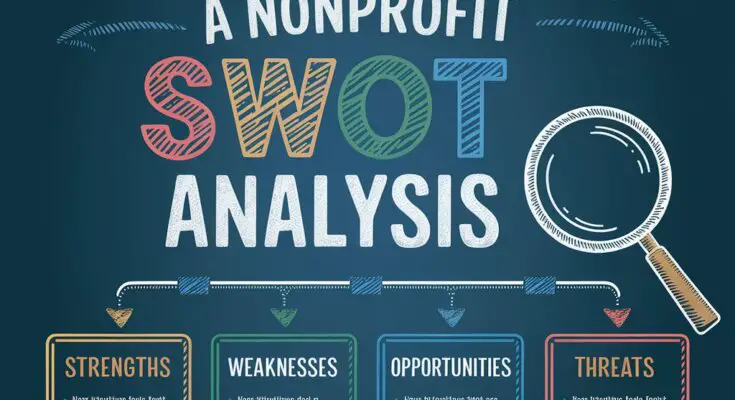In the nonprofit world, strategic planning is crucial for success and sustainability. One effective tool for guiding this process is the SWOT analysis.
Conducting a nonprofit SWOT analysis allows organizations to assess their Strengths, Weaknesses, Opportunities, and Threats in a structured way.
This approach not only clarifies where your organization currently stands but also helps set the stage for future growth.
In this blog post, we’ll explore how to conduct a nonprofit SWOT analysis in an easy-to-understand manner, complete with practical examples that you can apply immediately.
Understanding the Basics of SWOT Analysis
Before diving into the steps, let’s break down what SWOT analysis entails. The acronym stands for:
- Strengths: Internal factors that give your nonprofit an advantage over others.
- Weaknesses: Internal factors that place your nonprofit at a disadvantage.
- Opportunities: External factors that your nonprofit could capitalize on for growth.
- Threats: External factors that could challenge your nonprofit’s success.
By evaluating these four aspects, your nonprofit can develop strategies that maximize strengths and opportunities while minimizing weaknesses and threats. Let’s take a closer look at how to conduct a SWOT analysis for your nonprofit.
Step 1: Gather Your Team
Start by assembling a diverse team of stakeholders. This may include board members, staff, volunteers, and even beneficiaries. A diverse group ensures different perspectives are considered, leading to a more comprehensive analysis.
Example:
Imagine a nonprofit focused on youth mentorship. Including mentors, mentees, and board members in your SWOT analysis discussions will yield a richer understanding of your organization’s strengths and weaknesses.
Step 2: Brainstorm Strengths
Begin your analysis by focusing on strengths. Ask your team questions such as:
- What unique resources does our nonprofit possess?
- What skills do our team members bring to the table?
- What are our most significant achievements so far?
Encourage open discussion and list all the strengths you identify. Aim to be specific rather than vague.
Example:
A nonprofit that runs a food bank might identify its strong volunteer network as a strength. The organization could also note its long-standing relationships with local grocery stores that donate food.
Step 3: Identify Weaknesses
Next, shift your focus to weaknesses. Some questions to consider are:
- What areas need improvement in our operations?
- Are there any skills or resources we lack?
- What feedback do we receive from stakeholders about our services?
It’s important to approach this step with honesty and a willingness to improve. Acknowledge the weaknesses without assigning blame.
Example:
Using the food bank example, weaknesses might include limited storage space or insufficient marketing efforts to reach more community members in need.
Step 4: Explore Opportunities
Now, let’s turn our attention to opportunities. Think about external factors that could benefit your nonprofit. Consider the following questions:
- Are there upcoming funding opportunities we could pursue?
- Are there partnerships we could develop with other organizations?
- What trends in the community or the nonprofit sector could we capitalize on?
Encourage creativity during this brainstorming session; no idea is too far-fetched at this stage.
Example:
The food bank may recognize an increasing interest in healthy eating among community members. This could lead to opportunities for workshops on nutrition, potentially funded by health-related grants.
Step 5: Analyze Threats
Finally, identify any threats that could impact your nonprofit. Consider questions like:
- What challenges does our organization currently face?
- Are there changes in legislation that could affect us?
- Who are our main competitors, and how might they impact our work?
Example:
In the food bank scenario, a threat could be the rise in competition from new food distribution programs or changes in government funding that affect food assistance programs.
Step 6: Compile and Prioritize Your Findings
Once you’ve brainstormed for each category, compile the findings into a clear and concise format. This could be as simple as a four-quadrant chart, where each quadrant represents one aspect of the SWOT analysis.
Prioritization Tips:
- Focus on the top three to five items in each category. This ensures that your organization can effectively address the most significant points without becoming overwhelmed.
- Use voting or ranking methods to determine which strengths to leverage, weaknesses to address, opportunities to pursue, and threats to mitigate.
Step 7: Develop Actionable Strategies
With your SWOT analysis complete, it’s time to formulate strategies based on your findings. Here’s a simple way to create these strategies:
- Leverage strengths to take advantage of opportunities. For example, if your organization has strong community ties (strength) and sees an opportunity for partnership with a local school, pursue that partnership to enhance your programs.
- Use strengths to minimize threats. If you have a strong volunteer base, use that to mitigate the threat of reduced funding by organizing community fundraising events.
- Address weaknesses by exploiting opportunities. If your food bank lacks marketing skills but sees an opportunity in increased community interest in nutrition, consider hiring an intern or volunteer with marketing expertise to create awareness.
- Mitigate threats by addressing weaknesses. If competition is a threat due to limited resources, focus on increasing your storage capacity or improving your outreach efforts to solidify your position.
Example:
Consider a local nonprofit, “Hope for All,” dedicated to providing job training for underprivileged youth. During their SWOT analysis, they identified a strong network of local businesses willing to hire their graduates as a strength.
However, they also noted their limited funding as a weakness. As they explored opportunities, they discovered a new grant aimed at supporting job training programs, which they successfully applied for.
By leveraging their strengths and seizing the opportunity, “Hope for All” not only secured funding but also expanded their programs, resulting in more job placements for their graduates.
Putting It All Together
Conducting a nonprofit SWOT analysis is a powerful way to identify your organization’s current position and strategize for the future.
By following these steps, you can create a clear roadmap for success, ensuring that you capitalize on your strengths and opportunities while addressing weaknesses and threats.
For those looking to take a deeper dive into strategic planning, consider purchasing the Strategic Planning Guide for Nonprofits. This guide provides comprehensive insights into effective planning processes, tailored specifically for nonprofits.
Lastly, if you want to stay informed about more expert tips and resources for your nonprofit journey, subscribe to the Nonprofit Navigators Newsletter. As a subscriber, you will gain access to valuable opportunities, including job openings, grant prospects, exclusive webinars, and events designed to help your nonprofit thrive.
Don’t miss out—sign up today and empower your organization to make a lasting impact!
Additional Resources:
- The Small Business’s Guide to Winning Grants
- Request for Proposal Success: How to Write Proposals That Win
- The Ultimate Guide to Federal Grant Applications: Techniques for Success
- Digital Marketing for Nonprofits: A Comprehensive Guide to Boosting Your Impact Online
- Mastering Online Fundraising: A Nonprofit’s Guide to Digital Success




